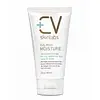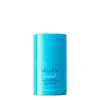What's inside
What's inside
 Key Ingredients
Key Ingredients

 Benefits
Benefits

 Concerns
Concerns

 Ingredients Side-by-side
Ingredients Side-by-side

Aloe Barbadensis Leaf Juice
Skin ConditioningCaprylic/Capric Triglyceride
MaskingGlyceryl Stearate
EmollientSucrose Laurate
EmollientSqualane
EmollientHelianthus Annuus Seed Oil
EmollientCetyl Alcohol
EmollientCurcuma Longa Root Extract
MaskingGanoderma Lucidum Extract
Skin ProtectingBeta-Glucan
Skin ConditioningAvena Sativa Kernel Extract
AbrasiveGlycerin
HumectantSimmondsia Chinensis Seed Oil
EmollientChamomilla Recutita Flower Extract
MaskingCamellia Sinensis Leaf Extract
AntimicrobialBisabolol
MaskingZingiber Officinale Root Extract
MaskingTocopherol
AntioxidantButyrospermum Parkii Butter
Skin ConditioningCopernicia Cerifera Wax
Silicon
AbrasiveWater
Skin ConditioningDehydroacetic Acid
PreservativeSodium Stearoyl Glutamate
CleansingXanthan Gum
EmulsifyingBenzyl Alcohol
PerfumingCitric Acid
BufferingMaltodextrin
AbsorbentAloe Barbadensis Leaf Juice, Caprylic/Capric Triglyceride, Glyceryl Stearate, Sucrose Laurate, Squalane, Helianthus Annuus Seed Oil, Cetyl Alcohol, Curcuma Longa Root Extract, Ganoderma Lucidum Extract, Beta-Glucan, Avena Sativa Kernel Extract, Glycerin, Simmondsia Chinensis Seed Oil, Chamomilla Recutita Flower Extract, Camellia Sinensis Leaf Extract, Bisabolol, Zingiber Officinale Root Extract, Tocopherol, Butyrospermum Parkii Butter, Copernicia Cerifera Wax, Silicon, Water, Dehydroacetic Acid, Sodium Stearoyl Glutamate, Xanthan Gum, Benzyl Alcohol, Citric Acid, Maltodextrin
Water
Skin ConditioningGlycerin
HumectantCaprylic/Capric Triglyceride
MaskingRicinus Communis Seed Oil
MaskingCetearyl Alcohol
EmollientJojoba Oil/Macadamia Seed Oil Esters
Skin ConditioningSolanum Tuberosum Pulp Extract
SmoothingBehenyl Alcohol
EmollientPropanediol
SolventHelianthus Annuus Seed Oil
EmollientEctoin
Skin ConditioningTocopherol
AntioxidantAllantoin
Skin ConditioningSqualene
EmollientFurcellaria Lumbricalis Extract
Skin ConditioningMomordica Charantia Fruit Extract
Skin ConditioningAmylopectin
Arnica Montana Flower Extract
MaskingAcetyl Glutamine
Skin ConditioningLecithin
EmollientPhytosteryl Macadamiate
Skin ConditioningPhospholipids
Skin ConditioningBeta-Glucan
Skin ConditioningLactobacillus Ferment
Skin ConditioningLithothamnion Calcareum Extract
Skin ConditioningBacillus/Soybean Ferment Extract
Skin ConditioningHexapeptide-11
Skin ConditioningOligopeptide-1
Skin ConditioningOligopeptide-2
Skin ConditioningOligopeptide-3
Skin ConditioningFolic Acid
Skin ConditioningSodium Hyaluronate
HumectantLactic Acid
BufferingPhytosterols
Skin ConditioningCeramide NP
Skin ConditioningPhytosphingosine
Skin ConditioningCeramide AP
Skin ConditioningCholesterol
EmollientCeramide EOP
Skin ConditioningCetearyl Glucoside
EmulsifyingPentylene Glycol
Skin ConditioningEthylhexylglycerin
Skin ConditioningPotassium Sorbate
PreservativeCaprylyl Glycol
EmollientSodium Benzoate
MaskingSodium Lauroyl Lactylate
EmulsifyingXanthan Gum
EmulsifyingCarbomer
Emulsion StabilisingCitric Acid
BufferingSodium Hydroxide
BufferingPhenoxyethanol
PreservativeWater, Glycerin, Caprylic/Capric Triglyceride, Ricinus Communis Seed Oil, Cetearyl Alcohol, Jojoba Oil/Macadamia Seed Oil Esters, Solanum Tuberosum Pulp Extract, Behenyl Alcohol, Propanediol, Helianthus Annuus Seed Oil, Ectoin, Tocopherol, Allantoin, Squalene, Furcellaria Lumbricalis Extract, Momordica Charantia Fruit Extract, Amylopectin, Arnica Montana Flower Extract, Acetyl Glutamine, Lecithin, Phytosteryl Macadamiate, Phospholipids, Beta-Glucan, Lactobacillus Ferment, Lithothamnion Calcareum Extract, Bacillus/Soybean Ferment Extract, Hexapeptide-11, Oligopeptide-1, Oligopeptide-2, Oligopeptide-3, Folic Acid, Sodium Hyaluronate, Lactic Acid, Phytosterols, Ceramide NP, Phytosphingosine, Ceramide AP, Cholesterol, Ceramide EOP, Cetearyl Glucoside, Pentylene Glycol, Ethylhexylglycerin, Potassium Sorbate, Caprylyl Glycol, Sodium Benzoate, Sodium Lauroyl Lactylate, Xanthan Gum, Carbomer, Citric Acid, Sodium Hydroxide, Phenoxyethanol
 Reviews
Reviews

Ingredients Explained
These ingredients are found in both products.
Ingredients higher up in an ingredient list are typically present in a larger amount.
Beta-Glucan is a polysaccharide. It can be derived from the cell walls of seaweed, oats, yeast, and fungi. It hydrates the skin and helps boost your skin's natural barrier.
As an antioxidant, beta-glucan helps fight free-radicals. Free-radicals are molecules that may damage your skin cells, such as pollution.
Studies show this ingredient may be an effective wrinkle reducer as it can deeply penetrate into skin. It has also been show to help with wound healing.
Learn more about Beta-GlucanThis ingredient is an emollient, solvent, and texture enhancer. It is considered a skin-softener by helping the skin prevent moisture loss.
It helps thicken a product's formula and makes it easier to spread by dissolving clumping compounds.
Caprylic Triglyceride is made by combining glycerin with coconut oil, forming a clear liquid.
While there is an assumption Caprylic Triglyceride can clog pores due to it being derived from coconut oil, there is no research supporting this.
Learn more about Caprylic/Capric TriglycerideCitric Acid is an alpha hydroxy acid (AHA) naturally found in citrus fruits like oranges, lemons, and limes.
Like other AHAs, citric acid can exfoliate skin by breaking down the bonds that hold dead skin cells together. This helps reveal smoother and brighter skin underneath.
However, this exfoliating effect only happens at high concentrations (20%) which can be hard to find in cosmetic products.
Due to this, citric acid is usually included in small amounts as a pH adjuster. This helps keep products slightly more acidic and compatible with skin's natural pH.
In skincare formulas, citric acid can:
While it can provide some skin benefits, research shows lactic acid and glycolic acid are generally more effective and less irritating exfoliants.
Most citric acid used in skincare today is made by fermenting sugars (usually from molasses). This synthetic version is identical to the natural citrus form but easier to stabilize and use in formulations.
Read more about some other popular AHA's here:
Learn more about Citric AcidGlycerin is already naturally found in your skin. It helps moisturize and protect your skin.
A study from 2016 found glycerin to be more effective as a humectant than AHAs and hyaluronic acid.
As a humectant, it helps the skin stay hydrated by pulling moisture to your skin. The low molecular weight of glycerin allows it to pull moisture into the deeper layers of your skin.
Hydrated skin improves your skin barrier; Your skin barrier helps protect against irritants and bacteria.
Glycerin has also been found to have antimicrobial and antiviral properties. Due to these properties, glycerin is often used in wound and burn treatments.
In cosmetics, glycerin is usually derived from plants such as soybean or palm. However, it can also be sourced from animals, such as tallow or animal fat.
This ingredient is organic, colorless, odorless, and non-toxic.
Glycerin is the name for this ingredient in American English. British English uses Glycerol/Glycerine.
Learn more about GlycerinHelianthus Annuus Seed Oil is the oil derived from the seeds of a Sunflower. Sunflower seed oil is non-fragrant. It is an emollient, meaning it helps to soften the skin.
Sunflower seed oil contains many fatty acids. The fatty acids found in sunflower seeds include (from highest amount to least): linoleic acid, myristic acid, palmitic acid, stearic acid, arachidic acid, oleic acid, and linolenic acid.
These fatty acids help the skin create ceramides. Ceramides play a role in repairing the skin barrier.
Helianthus Annuus Seed Oil helps moisturize the skin. This in turn helps the skin look more rejuvenated and smoother.
Sunflowers are rich in vitamin E.
Historians believe Indigenous cultures of North America domesticated sunflowers before corn. Thus they relied on sunflower oil for a variety of uses. One such use is moisturizing skin and hair.
Sunflower seed oil may not be fungal acne safe. We recommend speaking with a professional if you have any concerns.
Learn more about Helianthus Annuus Seed OilTocopherol (also known as Vitamin E) is a common antioxidant used to help protect the skin from free-radicals and strengthen the skin barrier. It's also fat soluble - this means our skin is great at absorbing it.
Vitamin E also helps keep your natural skin lipids healthy. Your lipid skin barrier naturally consists of lipids, ceramides, and fatty acids. Vitamin E offers extra protection for your skin’s lipid barrier, keeping your skin healthy and nourished.
Another benefit is a bit of UV protection. Vitamin E helps reduce the damage caused by UVB rays. (It should not replace your sunscreen). Combining it with Vitamin C can decrease sunburned cells and hyperpigmentation after UV exposure.
You might have noticed Vitamin E + C often paired together. This is because it is great at stabilizing Vitamin C. Using the two together helps increase the effectiveness of both ingredients.
There are often claims that Vitamin E can reduce/prevent scarring, but these claims haven't been confirmed by scientific research.
Learn more about TocopherolWater. It's the most common cosmetic ingredient of all. You'll usually see it at the top of ingredient lists, meaning that it makes up the largest part of the product.
So why is it so popular? Water most often acts as a solvent - this means that it helps dissolve other ingredients into the formulation.
You'll also recognize water as that liquid we all need to stay alive. If you see this, drink a glass of water. Stay hydrated!
Learn more about WaterXanthan gum is used as a stabilizer and thickener within cosmetic products. It helps give products a sticky, thick feeling - preventing them from being too runny.
On the technical side of things, xanthan gum is a polysaccharide - a combination consisting of multiple sugar molecules bonded together.
Xanthan gum is a pretty common and great ingredient. It is a natural, non-toxic, non-irritating ingredient that is also commonly used in food products.
Learn more about Xanthan Gum